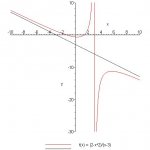You are using an out of date browser. It may not display this or other websites correctly.
You should upgrade or use an alternative browser.
You should upgrade or use an alternative browser.
Find the limit if it exist
- Thread starter serenity
- Start date
mmm4444bot
Super Moderator
- Joined
- Oct 6, 2005
- Messages
- 10,902
What a vague post. :roll:
Since I cannot read your mind, I have no idea what you already know about limits.
Since you did not ask any questions on your own about this limit, I have no idea why you're stuck.
Since you neither showed any work nor made any statements about what you're thinking, who knows what you expect?
(Why do people here so often play this kind of guessing game when seeking help?)
Also, we need to use grouping symbols when typing algebraic ratios.
I'll take a guess at the given expression.
\(\displaystyle y \;=\; \frac{-x^2 + 2}{x - 3}\)
This is a Rational function.
The degree of the numerator is one more than the degree of the denominator. That indicates a slant asymptote.
In other words, for infinitely large or infinitely small values of x, the graph of y looks like an oblique line.
Now, ask yourself this: when dealing with an oblique line, does y approach a constant value, as x approaches negative infinity?
In order for the given limit to exist, the value of y must approach a constant value, as x approaches negative infinity.
If I wrote anything that you do not understand, then please ask specific questions.
And try to remember that the more information you provide about your situation the better the responses you'll get back.
BigGlenntheHeavy
Senior Member
- Joined
- Mar 8, 2009
- Messages
- 1,577
Observe the graph. The black line (f(x) = -x-3) is an oblique asymptote to g(x) = (2-x^2)/(x-3) and x = 3 (red line) is a vertical asymptote..
[attachment=0:2gpwa71l]http://www.jpg[/attachment:2gpwa71l]
[attachment=0:2gpwa71l]http://www.jpg[/attachment:2gpwa71l]

